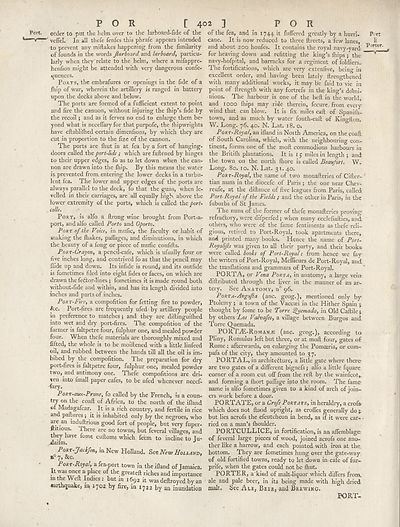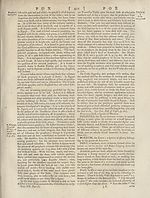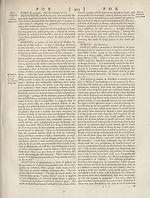Encyclopaedia Britannica > Volume 15, PLA-RAM
(448) Page 402
Download files
Complete book:
Individual page:
Thumbnail gallery: Grid view | List view

FOR L 4°2 ] FOR
Port. order to put the helm over to the larboard-fide of the
veffel. In all thefe fenfes this phrafe appears intended
to prevent any miltakes happening from the fnnilarity
of founds in the words Jlarboard and larboard^ particu¬
larly when they relate to the helm, where a mifappre-
heniion might be attended with very dangerous confe-
tpiences.
Ports, the embrafures or openings in the fide of a
fhip of war, wherein the artillery is ranged in battery
upon the decks above and below.
The ports are formed of a fufficient extent to point
and fire the cannon, without injuring the fhip’s fide by
the recoil ; and as it ferves no end to enlarge them be¬
yond what is neceflary for that purpofe, the fhipwrights
have eftablifhed certain dimenfions, by which they are
cut in proportion to the fize of the cannon.
The ports are fhut in at fea by a fort of hanging-
doors called the port-lids ; which are fattened by hinges
to their upper edges, fo as to let down when the can¬
non are drawn into the (hip. By this means the water
is prevented from entering the lower decks in a turbu¬
lent fea. The lower and upper edges of the ports are
always parallel to the deck, fo that the guns, when le¬
velled in their carriages, are all equally high above the
lower extremity of the ports, which is called the port-
, cells.
Port, is alfo a ftrong wine brought from Port-a-
port, and alfo called Porto and Oporto.
Port of the Voice, in mufic, the faculty or habit of
making the fhakes, paffages, and diminutions, in which
the beauty of a fong or piece of mufic confitts.
PoRT-Crayon, a pencil-cafe, which is ufually four or
five inches long, and contrived fo as that the pencil may
hide up and down. Its infide is round, and its outfide
is fometimes filed into eight fides or faces, on which are
drawn the fe£tor-lines ; fometimes it is made round both
without-fide and within, and has its length divided into
inches and parts of inches.
PoRT-Fire, a compofition for fetting fire to powder,
fee. Port-fires are frequently ufed by artillery people
in preference to matches; and they are diftinguifhed
into wet and dry port-fires. The compofition of the
former is faltpetre four, fulphur one, and mealed powder
four. When thefe materials are thoroughly mixed and
lifted, the whole is to be moiilened with a little linfeed
oil, and rubbed between the hands till all the oil is im¬
bibed by the compofition. The preparation for dry
port-fires is faltpetre four, fulphur one, mealed powder
two, and antimony one. Thefe compofitions are dri¬
ven into fmall paper cafes, to be ufed whenever necef-
dary.
PoRT-aux-Prune, fo called by the French, is a coun¬
try on the coaft of Africa, to the north of the ifland
of Madagafcar. It is a rich country, and fertile in rice
and paftures; it is inhabited only by the negroes, who
are an induftrious good fort of people, but very fuper-
ftitious. There are no towns, but feveral villages, and
they have fome cuftoms which febm to incline to Tu-
.daifm. ; J
PoRT-Jackfon, in New Holland. See New Holland,
n° 7, &c.
• PoRT-Royal, a fea-port town in the ifland of Jamaica.
It was once a place of the great eft riches and importance
mthe Weft Indies : but in 1692 it wasdeftroyed by an
•arthquake, 11* 1702 by fire, in 1722 by an inundation
of the fea, and in 1744. it fuffered greatly by a hum. «
cane. It is now reduced to three ftreets, a few lanes, H
and about 200 houfes. It contains the royal navy-yard *>orter'
for heaving down and refitting the king’s fliips ; the *
navy-hofpital, and barracks for a regiment of foldiers.
The fortifications, which are very' extenfive, being in
excellent order, and having been lately ftrengthened
with many additional works, it may be faid to vie in
point of ftrength with any fortrefs in the king’s do’mi-
nions. The harbour is one of the beft in the world,
and 1000 fhips may ride therein, fecure from every
wind that can blow. It is fix miles call of Spanilh-
town, and as much by water fouth-eaft of Kingfton.
W. Long. 76. 40. N. Lat. 18. o.
PORT-Royal, an illand in Noith America, on the coaft
of South Carolina, which, with the neighbouring con¬
tinent, forms one of the moft commodious harbours in
the Britilh plantations. It is 15 miles in length ; and
the town on the north ftiore is called Beaufort. W.
Long. 80. 10. N. Lat. 31. 40.
PoRT-Royal, the name of two monafteries of Cifter-
tian nuns in the diocefe of Paris ; the one near Chev-
reufe, at the diftance of five leagues from Paris, called
Port-Roy a l of the Fields ; and the other in Paris, in the
fuburbs of St James.
T. he nuns of the former of thefe monaftenes provincr
refractory , were difperfed; when many ecclefiafties, and
others, who were of the fame fentiments as thefe reli¬
gious, retired to Port-Royal, took apartments there,
and printed many books. Hence the name of Port-
Royalijls was given to all their party', and theii books
were called hooks of Port-Royal: from hence we fay
the writers of Port-Royal, Meflieurs de Port-Royal, and
the tranfiations and grammars of Port-Royal.
PORTA, or Vena Porta, in anatomy, a large veirr
diftributed through the liver in the manner of an ar¬
tery. See Anatomy, n° 96.
PoRTA-Angufa (anc. geog.), mentioned only by
Ptolemy; a town of the Vaccaei in the Hither Spain ;
thought by fome to be Torre ^uernada, in Old Caftile ;
by others Los Valvafes, a village between Burgos and
Torre Quemada.
PORTAL-Romana: (anc. geog.), according to
Pliny, Romulus left but three, or at matt four, gates of
Rome : afterwards, on enlarging the Pomocria, or com-
pafs of the city, they amounted to 3 7.
PORTAL, in architecture, a little gate where there
are two gates of a different bignefs j alfo a little fquare
corner of a room cut off from the reft by the wainfeot,.
and forming a ftiort paffage into the room. The fame
name is alfo fometimes given to a kind of arch of join¬
ers work before a door.
PORT ATE, or a Crofs Portate, in heraldry, a crofa
which does not fta».id upright, as croffes generally do ;
but lies acrofs the efeuteheon in bend, as if it were car- •
ried on a man’s ftioulder.
PORTCULLICE, in fortification, is an affemblage
of feveral large pieces of wood, joined acrofs one ano¬
ther like a harrow, and each pointed with iron at the.
bottom. They are fometimes hung over the gate-way
of old fortified towns, ready to let down in cafe of fur-
prife, when the gates could not be ftiut.
PORTER, a kind of malt-liquor which differs from,
ale and pale beer, in its being made with high dried
malt. See Ale, Beer, and Brewing.
PORT-
Port. order to put the helm over to the larboard-fide of the
veffel. In all thefe fenfes this phrafe appears intended
to prevent any miltakes happening from the fnnilarity
of founds in the words Jlarboard and larboard^ particu¬
larly when they relate to the helm, where a mifappre-
heniion might be attended with very dangerous confe-
tpiences.
Ports, the embrafures or openings in the fide of a
fhip of war, wherein the artillery is ranged in battery
upon the decks above and below.
The ports are formed of a fufficient extent to point
and fire the cannon, without injuring the fhip’s fide by
the recoil ; and as it ferves no end to enlarge them be¬
yond what is neceflary for that purpofe, the fhipwrights
have eftablifhed certain dimenfions, by which they are
cut in proportion to the fize of the cannon.
The ports are fhut in at fea by a fort of hanging-
doors called the port-lids ; which are fattened by hinges
to their upper edges, fo as to let down when the can¬
non are drawn into the (hip. By this means the water
is prevented from entering the lower decks in a turbu¬
lent fea. The lower and upper edges of the ports are
always parallel to the deck, fo that the guns, when le¬
velled in their carriages, are all equally high above the
lower extremity of the ports, which is called the port-
, cells.
Port, is alfo a ftrong wine brought from Port-a-
port, and alfo called Porto and Oporto.
Port of the Voice, in mufic, the faculty or habit of
making the fhakes, paffages, and diminutions, in which
the beauty of a fong or piece of mufic confitts.
PoRT-Crayon, a pencil-cafe, which is ufually four or
five inches long, and contrived fo as that the pencil may
hide up and down. Its infide is round, and its outfide
is fometimes filed into eight fides or faces, on which are
drawn the fe£tor-lines ; fometimes it is made round both
without-fide and within, and has its length divided into
inches and parts of inches.
PoRT-Fire, a compofition for fetting fire to powder,
fee. Port-fires are frequently ufed by artillery people
in preference to matches; and they are diftinguifhed
into wet and dry port-fires. The compofition of the
former is faltpetre four, fulphur one, and mealed powder
four. When thefe materials are thoroughly mixed and
lifted, the whole is to be moiilened with a little linfeed
oil, and rubbed between the hands till all the oil is im¬
bibed by the compofition. The preparation for dry
port-fires is faltpetre four, fulphur one, mealed powder
two, and antimony one. Thefe compofitions are dri¬
ven into fmall paper cafes, to be ufed whenever necef-
dary.
PoRT-aux-Prune, fo called by the French, is a coun¬
try on the coaft of Africa, to the north of the ifland
of Madagafcar. It is a rich country, and fertile in rice
and paftures; it is inhabited only by the negroes, who
are an induftrious good fort of people, but very fuper-
ftitious. There are no towns, but feveral villages, and
they have fome cuftoms which febm to incline to Tu-
.daifm. ; J
PoRT-Jackfon, in New Holland. See New Holland,
n° 7, &c.
• PoRT-Royal, a fea-port town in the ifland of Jamaica.
It was once a place of the great eft riches and importance
mthe Weft Indies : but in 1692 it wasdeftroyed by an
•arthquake, 11* 1702 by fire, in 1722 by an inundation
of the fea, and in 1744. it fuffered greatly by a hum. «
cane. It is now reduced to three ftreets, a few lanes, H
and about 200 houfes. It contains the royal navy-yard *>orter'
for heaving down and refitting the king’s fliips ; the *
navy-hofpital, and barracks for a regiment of foldiers.
The fortifications, which are very' extenfive, being in
excellent order, and having been lately ftrengthened
with many additional works, it may be faid to vie in
point of ftrength with any fortrefs in the king’s do’mi-
nions. The harbour is one of the beft in the world,
and 1000 fhips may ride therein, fecure from every
wind that can blow. It is fix miles call of Spanilh-
town, and as much by water fouth-eaft of Kingfton.
W. Long. 76. 40. N. Lat. 18. o.
PORT-Royal, an illand in Noith America, on the coaft
of South Carolina, which, with the neighbouring con¬
tinent, forms one of the moft commodious harbours in
the Britilh plantations. It is 15 miles in length ; and
the town on the north ftiore is called Beaufort. W.
Long. 80. 10. N. Lat. 31. 40.
PoRT-Royal, the name of two monafteries of Cifter-
tian nuns in the diocefe of Paris ; the one near Chev-
reufe, at the diftance of five leagues from Paris, called
Port-Roy a l of the Fields ; and the other in Paris, in the
fuburbs of St James.
T. he nuns of the former of thefe monaftenes provincr
refractory , were difperfed; when many ecclefiafties, and
others, who were of the fame fentiments as thefe reli¬
gious, retired to Port-Royal, took apartments there,
and printed many books. Hence the name of Port-
Royalijls was given to all their party', and theii books
were called hooks of Port-Royal: from hence we fay
the writers of Port-Royal, Meflieurs de Port-Royal, and
the tranfiations and grammars of Port-Royal.
PORTA, or Vena Porta, in anatomy, a large veirr
diftributed through the liver in the manner of an ar¬
tery. See Anatomy, n° 96.
PoRTA-Angufa (anc. geog.), mentioned only by
Ptolemy; a town of the Vaccaei in the Hither Spain ;
thought by fome to be Torre ^uernada, in Old Caftile ;
by others Los Valvafes, a village between Burgos and
Torre Quemada.
PORTAL-Romana: (anc. geog.), according to
Pliny, Romulus left but three, or at matt four, gates of
Rome : afterwards, on enlarging the Pomocria, or com-
pafs of the city, they amounted to 3 7.
PORTAL, in architecture, a little gate where there
are two gates of a different bignefs j alfo a little fquare
corner of a room cut off from the reft by the wainfeot,.
and forming a ftiort paffage into the room. The fame
name is alfo fometimes given to a kind of arch of join¬
ers work before a door.
PORT ATE, or a Crofs Portate, in heraldry, a crofa
which does not fta».id upright, as croffes generally do ;
but lies acrofs the efeuteheon in bend, as if it were car- •
ried on a man’s ftioulder.
PORTCULLICE, in fortification, is an affemblage
of feveral large pieces of wood, joined acrofs one ano¬
ther like a harrow, and each pointed with iron at the.
bottom. They are fometimes hung over the gate-way
of old fortified towns, ready to let down in cafe of fur-
prife, when the gates could not be ftiut.
PORTER, a kind of malt-liquor which differs from,
ale and pale beer, in its being made with high dried
malt. See Ale, Beer, and Brewing.
PORT-
Set display mode to:
![]() Universal Viewer |
Universal Viewer | ![]() Mirador |
Large image | Transcription
Mirador |
Large image | Transcription
Images and transcriptions on this page, including medium image downloads, may be used under the Creative Commons Attribution 4.0 International Licence unless otherwise stated. ![]()
| Encyclopaedia Britannica > Encyclopaedia Britannica > Volume 15, PLA-RAM > (448) Page 402 |
|---|
| Permanent URL | https://digital.nls.uk/191906600 |
|---|
| Attribution and copyright: |
|
|---|
| Description | Ten editions of 'Encyclopaedia Britannica', issued from 1768-1903, in 231 volumes. Originally issued in 100 weekly parts (3 volumes) between 1768 and 1771 by publishers: Colin Macfarquhar and Andrew Bell (Edinburgh); editor: William Smellie: engraver: Andrew Bell. Expanded editions in the 19th century featured more volumes and contributions from leading experts in their fields. Managed and published in Edinburgh up to the 9th edition (25 volumes, from 1875-1889); the 10th edition (1902-1903) re-issued the 9th edition, with 11 supplementary volumes. |
|---|---|
| Additional NLS resources: |
|

